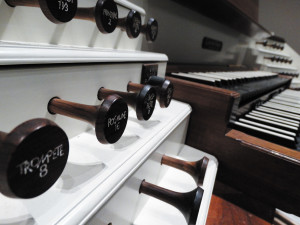For a few thousand years, music of faith has been sung and listened to and is still today, a significant part of worship. Sacred music has a profound effect on people all over the world. It has the power to enlighten, elevate one’s belief and to inspire one’s feeling of reverence. Today, even after many generations of the faithful have passed, music of faith is still a vital part of most church services.
Ironically, Michael Graziano, professor of Neuroscience at Princeton University, who apparently is a self-proclaimed atheist, said, “Something that goes beyond cultural impact unites music and religion. When listening to certain pieces of (sacred) music I feel a reverence creeping over me; an awe that has a spiritual quality.”
 Due to the enormity of this topic, my comments here are limited to Christian music traditions.
Due to the enormity of this topic, my comments here are limited to Christian music traditions.
Medieval Period
Musicologists can trace the beginnings of our Christian music to early Greek songs and Jewish chants and liturgy. Church music originally came from an oral tradition that was passed down from person to person.
Early church music was not notated or written down until the 10th or 11th Century. This was a very early form of notation – not like the notation we have today. The early chants were monophonic in nature, meaning one voice or one music line.
Pope Gregory I was credited with the founding and promulgation of the chant used in the Roman Catholic Church. He also established music schools in the church, hence the term, Gregorian chant has been used for centuries to describe the early chants. However, some historians have disputed the claim that Pope Gregory invented Gregorian chant.
As early as the 9th century, polyphony (that is, two or more combined melodic lines) first began. This laid the foundation for the future development of the traditions of western music. During this time, instrumental music was not as important as vocal music.
This early music, or chants, accompanied the Holy Mass and other rituals. The mass celebrated parts of the Eucharistic liturgy. The sections of the mass are Kyrie, Gloria, Credo, Sanctus and Benedictus and the Agnus Dei. The Requiem Mass or Mass for the Dead, was a modified version of the mass.
In this Medieval period, the Motet, a polyphonic choral composition, came into being and had a sacred text, usually in Latin and unaccompanied.
It was prevalent in the 13th through the 15th Centuries. It later had both sacred and secular texts and was the sacred counterpart to the popular secular madrigal.
The Reformation
After Martin Luther (1483-1546) led the Protestant Reformation in the early 16th Century, new forms of music led to the development of new church music. This was primarily in Germany, in the Lutheran Church and England, in the Anglican Church. Luther’s influence championed an event of great importance – the Protestant Chorale. This was an important development comparable to the Gregorian chant.
The chorale had a lasting influence on the Cantata that was the main type of German church music in the Baroque Period. This grew into the Oratorio and Passion by the great composers, Bach and Handel.
After 1750 great church music was not as present as before but the Oratorio continued uninterrupted. It became more prominent in the concert hall rather than the church. The Messiah by G. F. Handel is probably the most famous example of the Oratorio. Other large compositions of importance are the Requiem masses of Mozart, Brahms, Berlioz and Verdi, to name a few.
Hymns
Historically, Saint Paul mentioned hymns in his letters as early as A.D. 64. There was a plethora of hymn writing and singing favored by Martin Luther during the Reformation.
In England, Charles Wesley’s hymns, spread Methodist theology and were sung in many protestant churches, not just in Methodist churches. In 1779, Amazing Grace was written by Englishman John Newton. In 1972 the Royal Scots Dragoon Guards recording of Amazing Grace, featuring bagpipes, became a hit in both England and the United States.
Carl Boberg, wrote the words of How Great Thou Art, to the music of a Swedish folk melody. Later, Stuart Hine expanded the words and made his own arrangement. It has become one of the most popular hymns in the entire hymn repertory.
Holy, Holy, Holy, was written in 1826 by Reginald Heber. In 1529 Martian Luther wrote, A Mighty Fortress Is Our God and Isaac Watts wrote O God Our Help In Ages Past in 1719. These are just a few of the many great popular hymns of the Christian church, past and present.
Carols
Carols are a genre of music generally associated with the Christmas season. They are festive songs of joy and praise. Carols are usually religious in nature and used both in church and for secular occasions. Some carols date to the 13th Century and others trace their heritage to the early Middle-Ages. One can hear carols continuously throughout the Christmas season.
Spirituals
African American spirituals and gospel songs emerged from slavery times with elements from their native lands. ”When we sing gospel music, we are basically singing our prayers to God,” said Nancy Groeneveld, minister of worship & arts at Community Presbyterian Church in Danville, California. Spirituals and gospel songs are prevalent in religious settings as well as non-religious occasions.
Contemporary Music
Modern worship music is the predominating music in many Christian churches today. It is characterized by a range of styles influenced by popular forms of music. Historians have found that some churches began using contemporary songs in the 1960’s and they became very popular in the 1970’s.
The “Praise Band” has all but replaced the organ in contemporary church services. “The message in the music is positive…that God is there, not only in the good times but in the midst of our pain and struggles.” said Groeneveld.
The modern Praise Band consists of keyboard, lead guitar, secondary guitar, bass and drums. Sometimes strings, woodwinds and brass instruments are added. Also the hymnals have basically disappeared and often words to songs are projected on large screens. This practice has virtually eliminated part singing from church music.
The word of God, through music, has been spread by various musical styles throughout the ages. The richness of the past heritage and the legacy of Christian people have been immortalized by the inspiration and creativity of contemporary composers. The music of faith is here to stay.
Please submit your questions and comments to banddirector01@comcast.net
Visit our website at www.danvilleband.org for up-to-date information about the Danville Community Band.




